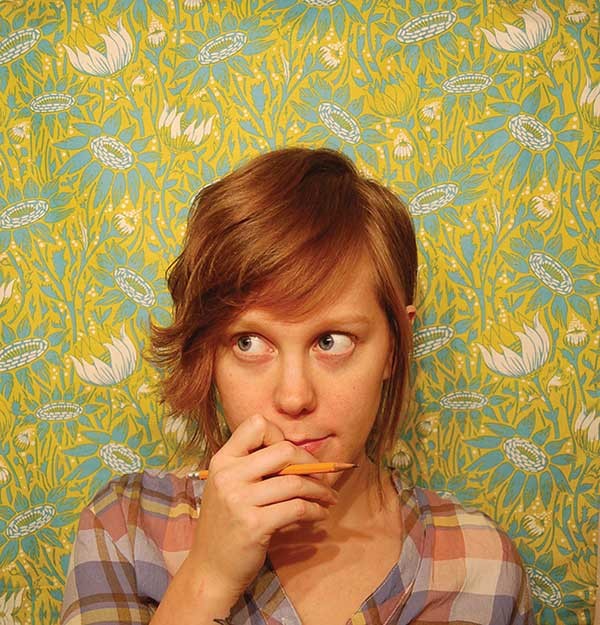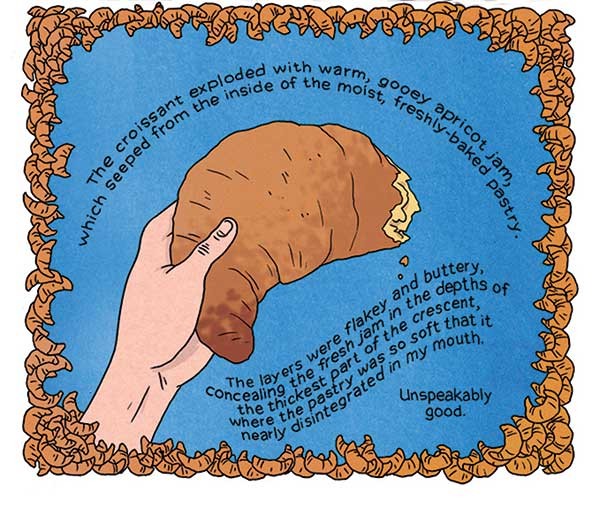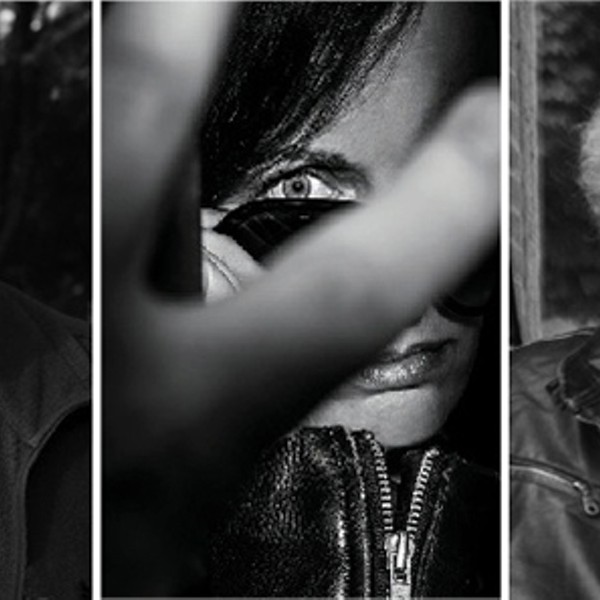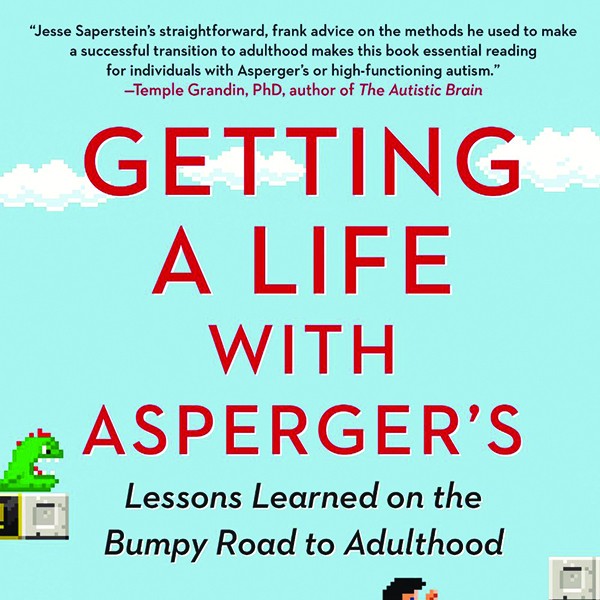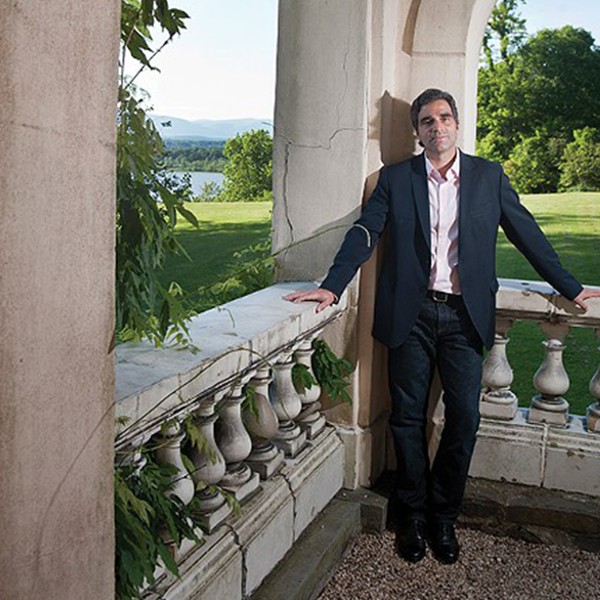Lucy Knisley is worried about the camera crew. "How are they even going to fit?" she asks. "My apartment is shoebox-sized."
That's not the only dilemma facing the Rhinebeck-raised author, who's about to film a cooking demonstration for MTV Geek. There's also the pressing issue of what to cook. "I'm not a professional chef," Knisley says. "When I'm cooking for other people, I make elaborate meals, but for me, it's more likely sautéed carrots. That's kind of my jam right now. Maybe some toast on the side."
Why all the fuss about what a 28-year-old comic artist makes for dinner? One look at her just-released graphic novel Relish: My Life in the Kitchen (First Second, 2013) and its predecessor French Milk (Touchstone, 2008) and all becomes clear: This is a writer who knows how to eat. If you don't think a cartoon can make your mouth water, you haven't read Lucy Knisley.
"I'm one of those grassroots, got-started-on-the-Internet people," says Knisley, whose voice is so cheerful she often sounds ready to laugh. She self-published French Milk with Rhinebeck's Epigraph, and was selling books off the end of a friend's table at the Comic Arts Festival when an editor from Touchstone scooped it up.
In lively drawings, words, and occasional photos, French Milk describes a six-week stay in Paris by the author (then 22) and her mother, a professional caterer who shares her love of art and food—not necessarily in that order. "In our family photo albums, there are literally more photos of meals than of actual people," Knisley says. French Milk won rave reviews in USA Today, People, Glamour, and a slew of food blogs. Four years ago, Knisley sold the film rights (no movement yet, though the option's been renewed).
Relish is a memoir in 12 food-themed chapters, from early childhood to the molecular gastronomy kitchen of Chicago's legendary Alinea. After a brief introduction (including a recipe for a maple-infused spice tea you can savor while reading the rest of the book), its first words are, "I was a child raised by foodies."
Indeed. The opening frames show young Lucy eating poached salmon in cream in her high chair, watching her mom blowtorch creme brulee for her classmates instead of the usual birthday cupcakes, and coloring on the kitchen floor at David Bouley's restaurant (Sample dialogue: "Want a profiterole, kiddo?").
When her parents divorced, the seven-year-old was shanghaied to Dutchess County, where her mother's newfound obsession with boring garden stores led her to try hailing a taxi on a rural dirt road. Eventually, she was seduced by Greig Farm's u-pick strawberries and farmstand honey straws.
Teenage rebellion manifested in a defiant love of junk food, with Lucky Charms and blue ketchup as gateway drugs. In one panel, tween Lucy chows down on McDonald's takeout in her father's Rome hotel room. ("How can you DO that?!" he shouts in bright red, and she answers, "With relish.") But gastronomy is destiny, and she soon joins her mother as a Rhinebeck Farmers' Market worker, artisanal cheesemonger, and catering assistant at Annie Leibovitz photo shoots and the opening of Dia:Beacon. (About to head off to art school, the 18-year-old server has a mystical private encounter with Richard Serra's newly installed Torqued Ellipses in the book's only full-page frame.)
All this unfolds in a sparkling palette and clean, expressive drawings. And each chapter ends with a relevant recipe, every step drawn and described in loving, often hilarious detail ("Try to control your drool long enough to reduce the mixture for about 2 min.")
Knisley's inspirations included Toast, a memoir by British food columnist Nigel Slater, and David Lebovitz's The Sweet Life in Paris. "I liked the idea of adding a sensory element—taste, the sense memory of recipes that go with the story. And comics are visual, so that adds another layer." She also cites the food drawings made by sculptor Claes Oldenburg when his wife developed multiple food allergies, "presented in all these cool, sculptural, toppling ways, so she could visually digest it."
Relish grew out of a food-and-travel project Knisley drew during graduate school at the Center for Cartoon Studies in Vermont. The first version was in black-and-white. "I always wanted to do it in color—that's a big part of the experience of food—but in grad school I didn't have enough money for color printing," she explains. Her agent sent three early chapters and a book proposal to prestigious graphic novel publisher First Second, which promptly made an offer. Knisley spent a year juggling the demands of an MFA thesis and a looming book deadline, "then buckled down and got to work."
She starts with a story, typed in paragraphs, then draws thumbnails, figuring out what will go into each panel and removing any text that can be shown in a drawing. Then she makes a rough sketch layout, penciling the pages. Next comes inking, text lettering, and color. All these steps, she points out in a recent Tumblr sketch, can be done in pajamas without leaving home.
Knisley has kept an online drawn journal for years, writing comics about such personal matters as breaking up with her long-time boyfriend. "That online connection is very intimate," she acknowledges. "It's all about communicating and creating a bond with readers." Obsessed with comics since she was a kid reading Archie and Tintin, she started drawing autobio comics as a painting student at the Art Institute of Chicago, as "an act of communication when I felt really isolated. I didn't have the socialization thing down. I was miserable, alone; I would sit in my room all day and make comics. It was my way of saying, 'I'm here.'"
Emotional honesty is paramount. Knisley expresses frustration with online reviewers who criticized French Milk for her character's flaws and occasional self-absorption. "You don't have to be perfect to be a strong female character. You can have pettiness, bad days, moodiness. That's what being 22 feels like."
Is she ever uncomfortable when strangers feel as if they know her? Not at all, Knisley says. "I'm very flattered when people know me and my work, when a stranger comes up to me at a convention and asks, 'How's your cat?' It's work I make public. I'm very honest, but I'm not putting anything out there I'm not comfortable with." Many autobio comics are far more revealing; she recalls being on a panel with Chester Brown, author of Paying for It: A Comic Strip Memoir of Being a John. "I read his book and thought, 'I know a lot about you.' But it's not like people are trying to pick me up. For me, it usually means readers bring me snacks. Which is good."
Knisley prefers "comic artist" to "graphic novelist" because comics is an all-encompassing term, covering everything from single-panel cartoons to superhero comic books to literary memoirs. "It helps to de-seriousify the graphic novel thing," she explains. "I'm happy to make work that's not Art Spiegelman's Maus, about a Holocaust survivor, or Alison Bechdel's Fun Home, about her father's suicide."
"I love those books," Knisley adds (her ardor appears to be mutual: Bechdel's jubilant blurb appears on the cover of Relish). "But I'm happy to bring a different voice to graphic novels. There's a lot of downer stuff, because you're not going to find a lot of people who make comics because they're well-adjusted and happy, and now they want to be crazy artists who spend all their time drawing and stay in a house, like, forever."
Knisley shows no sign of staying indoors forever. Along with her books and ongoing webcomic, she's designed T-shirts, posters, and roller derby logos; produced a CD, Pretty/Nerdy; and now does freelance illustration and journalism for Time Out, New City, Huffington Post, and Saveur, where she landed her dream gig: travel food writer ("All the things I like!"). She's been to Korea, Africa, and Australia, but one of her favorite culinary destinations is right up the river.
"A lot in Relish stems from my youth in the Hudson Valley," Knisley says. "The food growing in my neighbor's backyard is what we'd have in our salad bowl for dinner. I really miss that. I live in New York, and I lived in Chicago before that. So much of working on Relish was about reconnecting to my youth and to this place. And now I can hop a train, go upstate, and my mom will feed me amazing food."
She also gets amazing Hudson Valley food from the Union Square Greenmarket, where she sometimes buys produce from her former bosses. Knisley recalls selling mushrooms at a farmers' market one frigid day in November, and being so cold that a customer took pity and gave her gloves. Now she's a customer herself. "I've been buying these beautiful purple carrots, probably grown by one of my mom's neighbors," she says, sounding dreamy. Maybe she'll make sautéed carrots for MTV after all.
This is the drill: "Heat butter and olive oil in a big pan, about half and half—I like a little more butter. Peel the carrots and cut them into matchsticks. Throw them in and cook them for about five minutes. Right at the end, add a little salt and sugar. That's the secret weapon—it caramelizes them. When they get just a little limp, take them out. Or if you're like me, eat them right out of the pan."
Sounds good enough to draw.
Lucy Knisley will appear 4/4 at 7pm at Oblong Books & Music, Rhinebeck and 5/4 at 4pm at the Hudson Opera House.







